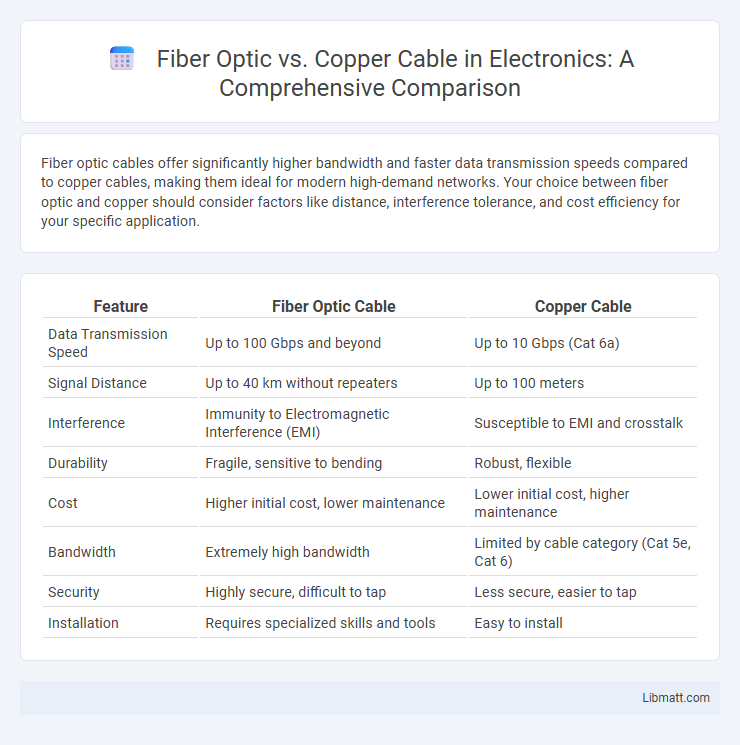Fiber optic cables offer significantly higher bandwidth and faster data transmission speeds compared to copper cables, making them ideal for modern high-demand networks. Your choice between fiber optic and copper should consider factors like distance, interference tolerance, and cost efficiency for your specific application.
Table of Comparison
| Feature | Fiber Optic Cable | Copper Cable |
|---|---|---|
| Data Transmission Speed | Up to 100 Gbps and beyond | Up to 10 Gbps (Cat 6a) |
| Signal Distance | Up to 40 km without repeaters | Up to 100 meters |
| Interference | Immunity to Electromagnetic Interference (EMI) | Susceptible to EMI and crosstalk |
| Durability | Fragile, sensitive to bending | Robust, flexible |
| Cost | Higher initial cost, lower maintenance | Lower initial cost, higher maintenance |
| Bandwidth | Extremely high bandwidth | Limited by cable category (Cat 5e, Cat 6) |
| Security | Highly secure, difficult to tap | Less secure, easier to tap |
| Installation | Requires specialized skills and tools | Easy to install |
Introduction to Fiber Optic and Copper Cables
Fiber optic cables use light to transmit data through thin strands of glass or plastic, offering significantly higher bandwidth and faster speeds compared to copper cables. Copper cables transmit electrical signals through metal wires, making them more susceptible to electromagnetic interference and signal degradation over long distances. Your choice between fiber optic and copper cables impacts network performance, reliability, and scalability.
How Fiber Optic Cables Work
Fiber optic cables transmit data through light pulses generated by lasers or LEDs that travel along thin strands of glass or plastic fibers. These fibers use total internal reflection to guide the light signals over long distances with minimal loss and interference, providing higher bandwidth and faster speeds than copper cables. Understanding how fiber optic cables work can help you choose the best solution for high-speed and reliable network connectivity.
How Copper Cables Work
Copper cables transmit data through electrical signals sent over copper wires, relying on conductive metal to carry current between devices. These cables are susceptible to electromagnetic interference and signal degradation over long distances, which can affect performance and reliability. Understanding how copper cables work helps you choose the right medium for networking needs based on distance, speed, and environment.
Speed and Bandwidth Comparison
Fiber optic cables offer significantly higher speed and bandwidth capabilities than copper cables, supporting data transmission rates up to 100 Gbps and beyond, compared to copper's maximum of around 10 Gbps. The fiber optic medium utilizes light signals, which experience less signal degradation over long distances, ensuring consistent high-speed performance. Copper cables rely on electrical signals that are more susceptible to electromagnetic interference, limiting their bandwidth and speed efficiency.
Signal Transmission and Distance Limitations
Fiber optic cables offer superior signal transmission with minimal signal loss and interference, enabling high-speed data transfer over long distances up to 40 kilometers or more without degradation. Copper cables experience significant signal attenuation and electromagnetic interference, limiting effective transmission distances typically to 100 meters for Ethernet connections. Your network performance benefits from fiber optics when extended range and reliable high-bandwidth communication are essential.
Durability and Environmental Resistance
Fiber optic cables offer superior durability and environmental resistance compared to copper cables, as they are less susceptible to corrosion, electromagnetic interference, and temperature fluctuations. Copper cables can degrade over time due to moisture and metal oxidation, leading to signal loss and shorter lifespan. Investing in fiber optic technology ensures greater reliability and longevity for Your network infrastructure in harsh or variable environmental conditions.
Installation Complexity and Flexibility
Fiber optic cables require precise handling and specialized tools for installation due to their fragile glass fibers, making the process more complex and time-consuming compared to copper cables. Copper cables offer greater flexibility during installation with easier termination and splicing, reducing labor time and costs in various environments. Fiber optic cables, despite their challenging installation, provide superior durability and resistance to electromagnetic interference, essential for high-performance networks.
Cost Analysis: Fiber Optic vs Copper Cable
Fiber optic cables generally have higher initial installation costs compared to copper cables due to advanced materials and specialized labor requirements. However, fiber optic offers superior long-term cost savings through lower maintenance expenses, higher durability, and greater data transmission efficiency. Choosing fiber optic can reduce your total cost of ownership, especially for high-bandwidth or long-distance network applications.
Security and Data Integrity
Fiber optic cables offer superior security and data integrity compared to copper cables due to their immunity to electromagnetic interference and inability to be tapped without detection. Copper cables are more vulnerable to signal degradation and eavesdropping, which can compromise sensitive information during transmission. Ensuring your network uses fiber optic technology significantly reduces risks associated with data breaches and maintains high-quality, reliable communication.
Choosing the Right Cable for Your Needs
Fiber optic cables offer higher bandwidth and faster transmission speeds, making them ideal for long-distance and high-data applications, whereas copper cables provide cost-effective solutions for shorter distances and lower-speed networks. Factors such as installation environment, budget constraints, and required data transfer rates are critical when selecting between fiber optic and copper cabling. Evaluating network scalability and interference susceptibility helps determine the optimal cable type to meet current and future connectivity needs.
Fiber Optic vs Copper Cable Infographic

 libmatt.com
libmatt.com